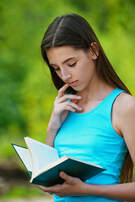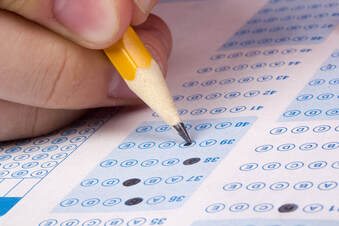 Whether you're just beginning your high school years or approaching its conclusion, thoughts about college performance and future career paths may linger in your mind. If these questions resonate with you, now is an opportune moment to consider taking an academic course or two this summer. Here's some of the immediate benefits: College Readiness: Preparing for standardized tests like the SAT or ACT during the summer can significantly impact your college prospects. Test prep courses not only equip you with effective strategies but also provide ample practice opportunities, potentially boosting your scores by several points and enhancing your chances of securing scholarships or gaining admission to your desired college. Flexibility and Reduced Pressure: High school life often involves juggling numerous commitments, from extracurricular activities to part-time jobs, leaving little breathing room during the academic year. Summer courses offer a less hectic environment, allowing you to focus on subjects that may have posed challenges during the school year or to delve deeper into favorite academic areas. Enhancement of Life Skills: While traditional academic classes primarily focus on subject matter, summer courses can offer valuable life skills training. From time management and personal finance management to honing study techniques and critical thinking abilities, these courses prepare you not only for academic success but also for future endeavors in the workplace. Combatting the "Summer Slide:" Have you ever returned from summer break only to find that your grasp of certain subjects has weakened? The phenomenon known as the "summer slide" can erode academic skills over the break. By enrolling in summer courses in subjects like math or English, you can keep your skills sharp and seamlessly transition into the next school year. Gaining Ground In Challenging Subject: Are you considering tackling an AP class or looking to improve in a subject where you've faced difficulties? Summer courses offer personalized support and concentrated instruction, helping you build confidence and proficiency in challenging subjects before the new academic year begins. Investing your summer in academic pursuits balanced with other summer activities strengthens your academic skills and helps you prepare for college. At iLearn Academy, we offer a full range of courses from test prep, chemistry, biology, and advanced math courses, and more.
2 Comments
 Students, Parents, Teachers: You may have already heard that the SAT and ACT are quickly transitioning to digital, rather than the more familiar pen-and-paper, testing. For the SAT, some drastic changes are coming with the shift—for the ACT, things are staying more or less the same. We wanted to take a moment to outline things and how they’ll affect test-taking starting in Spring 2024. What’s changing about the SAT? The SAT Suite of Assessments is becoming fully digital for all students beginning in Spring 2024. The digital SAT will be accompanied by a number of other changes to the exam. For students taking the PSAT 8/9 and PSAT/NMSQT, digital testing will be introduced this semester, Fall 2023, in order to get them acquainted with the digital format of the SAT, next semester. Why are these changes being introduced? The College Board has decided to take measures to match the pace at which students today are utilizing technology. You’ve probably already experienced, or seen your students experience most of their classes using some form of technology in the classroom. Taking the SAT digitally will also allow testing to be administered more flexibly. Will there still be a pen-and-paper option? No, the SAT will be full digital by Spring 2024 for all students. Guidebooks, practice tests, and other support materials will also be entirely digital. What if the student does not have a device they can use on test day? College Board will be able to provide any student a testing device in case they need one. What else is changing about the SAT? The structure and format of the SAT will be changing drastically as well. There will only be two sections, ‘Reading & Writing’ and ‘Math.’ While students will have more time per person, the exam will take less time overall, being shortened by an hour. In the Reading & Writing section, questions will be paired 1:1 with much shorter passages, rather than multiple questions associated with much longer passages. In the Math section, students will be able to use a calculator for the entire section. The sections will be ‘adaptive’ as well, meaning that they will be separated into two modules; the questions that appear in the second module of each section will be based on answers the student gives in the first module. The score will still be out of 1600, but the results will arrive in a matter of days, rather than weeks. What’s changing about the ACT? The ACT will also be trialing a digital version of their exam beginning in December 2023 for a small pilot group. Otherwise, however, the ACT is staying the same between paper and digital versions. What do I need to do? Stay up to date on new material coming from College Board that lines up with the changes in test structure and content. As always, iLearn Academy is here to help with digitial practice tests and personalized instruction. We will be caught up on the most recent information from both College Board and the ACT in order to help you or your student succeed, no matter what changes come our way. Turkey Day has come and gone, holiday music is becoming inescapable, the streets twinkle with lights… it must be time to start thinking about New Year's resolutions! Whether you’re trying to build lifelong habits, learn new study skills for school, or are just interested in general self-improvement, we’d like to give your motivation a boost by equipping you with techniques to choose realistic goals and feel the sense of accomplishment that comes with actually achieving them.  Before you create a wishlist of every lofty resolution that comes to mind, remember that not all goals are created equal. S.M.A.R.T. goals help us work smarter, not harder! The concept of a S.M.A.R.T. goal was introduced by George Doran, Arthur Miller, and James Cunningham in the 1981 article, “There’s a S.M.A.R.T. way to write management goals and objectives.” A handy acronym to keep in mind when creating goals, S.M.A.R.T. stands for Specific, Measurable, Attainable, Realistic, and Time-bound. Have you ever made a big New Year's resolution such as, “I will eat healthy,” or “I will be more organized?” Were you able to stick to that broad, vague goal? Probably not! Defining specific and measurable goals allows you to determine a realistic scope and timeframe for your goal, making that goal more possible to understand, pursue, and achieve. Consider these two examples of S.M.A.R.T. goals:
Everything goes back to your “why.” When setting a goal, you should understand why you want to set it. What behaviors, patterns, or assumptions do you want to change? Why is this change important to you, and why is it important right now? Once you understand the “why” that is driving your goal-setting, you will be able to better determine the most productive ways to go about achieving your aims, helping you clarify your S.M.A.R.T. goal. Once you know your “why” and have created your S.M.A.R.T. goal, it’s time to enact your plan. While S.M.A.R.T. goals can help you define and focus your goals, the journey of how to achieve them is up to you! Remember that “slow and steady” wins the race, as the saying goes. When working toward a goal, it’s important to take the long view and to work at a level that you can keep up over time. If you start in a “sprint,” attempting to accomplish everything at once, you will most likely fail. Instead of setting yourself up for failure and discouragement, generate some momentum for yourself by celebrating small successes and reinforcing small habits. Need some tools to stick with it? According to Atomic Habits: An Easy & Proven Way to Build Good Habits & Break Bad Ones by James Clear, we can leverage the Four Laws of Behavior Change to build better habits. According to this theory, you have more of a chance of building a new habit if the habit is obvious, attractive, easy, and satisfying. Think of people who lay out their workout clothes before going to bed, or even sleep in them so that there is no excuse not to exercise in the morning! Consider those who choose a type of exercise that they genuinely enjoy, instead of trying and failing to commit to an activity that they don’t like doing. Using these tricks, your new habit will eventually become automatic. Just think, soon, instead of dragging yourself to the gym, it will feel strange not to go to the gym. You may even miss it! Your new habit will integrate into your life, enabling you to
maintain and achieve your S.M.A.R.T. goal. What are your New Year's resolutions? Can any of them be made into S.M.A.R.T. goals? As the year winds down, now is the ideal time to start brainstorming some S.M.A.R.T. goals for yourself. New Year's Resolutions don’t have to be all about dieting and exercising; remember that academic goals can be productive resolutions too. Along the journey, remember to celebrate your successes, both big and small. As Clear suggests in Atomic Habits, “All big things come from small beginnings. The seed of every habit is a single, tiny decision.” Here’s to a proactive and productive New Year! Tutoring may be more important than ever as a recent study has confirmed what many educators suspected to be true: American student test scores have decreased over the past two pandemic-defined years. In “Those Grade-School Test Scores Are a Really Bad Sign” for Slate.com, Shirin Ali references math and reading scores reported by The National Assessment of Educational Progress (NAEP). These scores revealed notable declines in math and reading skills among fourth and eighth graders across America. In fact, every single state showed “straight declines or no significant changes.” A bad “report card,” indeed. Given that test scores may have a connection with high school completion, college success, and adult livelihood, the stakes are high as experts discuss how to recover from pandemic-era learning loss. While former NPR education reporter and author Anya Kamenetz is not surprised that student test scores have decreased over the past two years, she sees this decline as an alarming cause for concern. In an interview with Ali, Kamenetz offers her thoughts on the meaning of these scores, possible remedies, and key takeaways. 1. It is not about the score; it is about the implications Emphasizing the far-reaching significance of declining test scores, Kamenetz points out that there is little historical precedent to support a shift in education from the current reality to the benchmarks educators want students to achieve. Meanwhile, more students are foregoing college, further building on a 20 percent drop in community college admissions since the beginning of the pandemic. While the federal government has pumped money into education, schools are not necessarily using the money “in research-affirmed ways.” While Kamenetz agrees that increased funding is needed, she also stresses that, ultimately, learning recovery takes time.  2. High-dose tutoring is one of the solutions. High-dose tutoring is one of the research-backed solutions that combats learning loss. High-dose tutoring means tutoring a few times a week with specially trained teachers, either in one-to-one or small group settings. Kamenetz suggests that many students can benefit from tutoring to address learning gaps, noting that pandemic-related learning loss is somewhat different from other kinds of academic difficulties. Despite the potential of tutoring as an effective remedy for learning loss, parent buy-in presents obstacles. A survey by Brookings Institution found that less than 50% of parents reported that their child’s school was offering tutoring and/or summer school. Moreover, just over 25% of parents indicated interest in tutoring. Describing a mutual “communication problem” between schools and parents, Kamenetz notes that schools are not effectively communicating the urgency of the need for extra learning time. Parents are not understanding that their children are behind because priorities have changed. Instead of familiarizing themselves with grade-level benchmarks, parents are focused on social-emotional aspects of school in the wake of the pandemic. In addition to this necessary emphasis on wellbeing, academic gaps need to be addressed in order to ensure student success. 3. Taking action now can pave the path for success!
As the new reality of low test scores and learning loss continues to set in, what can parents do? Kamenetz suggests starting a conversation with your student's teacher to pinpoint where extra help is needed. High-dose tutoring sessions, after-school programs, summer school, and extended school–day and school–year initiatives are all possible solutions. At iLearn Academy, we believe in a personalized approach to tutoring that helps students achieve academic success. With ten years of experience providing quality tutoring and measurable results, we are ready to help students fill in academic gaps and recover from learning loss.
Who wants to spend an evening waiting in a locker-littered hallway or jammed into a tiny desk? I don’t see many parents raising their hands!
Despite its associations with discomfort and even conflict, parent-teacher conferences are an opportunity for parents and teachers to strengthen the connection between school and home, promoting student success. Whether your parent-teacher conference will be held virtually or in-person this fall, here are some key tips to keep in mind: 1. Attend! It’s no secret that parent-teacher conferences can be poorly attended, especially beyond elementary school. Even if your child gets good grades, conferences offer an insight into all aspects of the school experience, from academics to social behaviors. Utilize conferences as an opportunity to be involved in your child’s school community and help advance your child’s education. Especially since the widespread adoption of virtual conferences during the pandemic, schools may offer flexible formats to make conference scheduling easier for everyone. Connect with your child’s school if you need to reschedule or request to attend via an alternate format. 2. Arrive prepared. With grades and behavior often topping the list of discussion points, parent-teacher conferences can be stressful enough. Ease your mind by arriving prepared. If the teacher sends a meeting agenda before the conference, have this handy so that you can anticipate how your priorities fit into the teacher's plan, helping you make the most of your meeting time. If you really want to do your homework, review the school handbook, the class syllabus, and/or any classroom policies that can help you better understand the expectations and experiences of your child before you set foot in their classroom. 3. Involve your student. Although students are not always invited to parent-teacher conferences, this doesn’t mean that they shouldn’t be involved. This meeting is about them, after all! Before the conference, ask your child how they feel about school and if there is anything they need from their teacher. Consider bringing your student to the conference, provided that the school allows it and that your student is able to participate in a conversation about successes and challenges. After the conference, debrief with your child. Reiterate or explain any action plans and remind them that you want them to succeed. 4. Focus on more than academics. While parent-teacher conferences may center on academic performance, they are also an opportunity to discuss social and emotional aspects of the educational experience. Your child’s teacher(s) may be able to give you valuable insight into your child’s social skills, friendships, and general behavior at school. 5. Remember that you are on the same team. Two-way communication is the key to any successful parent-teacher partnership. While parent-teacher conferences can trigger anxiety on both sides, an effective conference focuses on solutions, not only on problems. Don’t hesitate to ask the teacher to explain or elaborate. Whether it's the name of an assessment, a unit concept, or a specific student behavior, ask the teacher for clarification when needed. 6. Ask for resources or an extra meeting, if needed. Most parent-teacher conferences are tightly scheduled, meaning that it may not be possible to cover every topic on your list. Want to know more about test prep, reading strategies, or community resources? The teacher may have a recommendation or may be able to point you in a productive direction, even if time doesn’t allow for a deeper conversation on the topic. Ultimately, if you feel that an additional meeting would be beneficial, ask! Effective parent-teacher conferences are a central component of a successful parent-teacher partnership. As you engage with your student’s educational journey during upcoming parent-teacher conferences, remember that iLearn Academy is here to support you! To learn more, email us at [email protected], call us at (847) 834-0791, or fill out our online request form here. “What advice would a wisdom tooth have?” “You are on an expedition to found a colony on Mars…” “If you could give any historical figure any piece of technology, who and what would it be…” These are parts of three of the University of Chicago’s extended essay prompts for the 2022-2023 admissions cycle. While essay prompts for the Common App, accepted by over 900 colleges and universities, may not raise as many eyebrows, every college essay is an opportunity for applicants to showcase their individual voices, perspectives, and even quirks! According to a 2019 study by the National Association for College Admission Counseling, 33.2% of 220 schools surveyed considered the college essay or writing sample to have moderate importance in the admissions process, while 23.2% assigned it considerable importance. While highly selective colleges have long tended to place more weight on the college essay than less competitive schools, the essay is arguably more important than ever in 2022’s increasingly competitive admissions landscape. On top of that, given the pandemic-driven rise of test-optional admissions policies, the essay may literally carry more weight; the absence of test scores means one less application component for admissions committees to consider. With the pressure to write an outstanding college essay as high as ever, it is never too early to begin learning about the process. To kick off, we will cover two themes that surface near the beginning of the essay-writing journey: understanding the purpose of college essays and selecting a prompt.  What is the point of college application essays? First and foremost, the essay is an opportunity to showcase your personality within your application. Admissions officers will receive plenty of information about you in the body of your application, from your grades, to your academic course load, to your roster of extracurricular activities. While each of these puzzle pieces fills in part of your story, the college essay is your chance to tell your story in your own words. It is an opportunity to showcase what you want the admissions committee to know about you, your motivations, and your values. Of course, the college essay also allows you to demonstrate your ability to communicate effectively and engagingly in writing. Whether or not writing is your forte, the college essay is one component of your application that is completely under your control! Because you have the chance to work on your essay well before submission time, admissions officers will expect it to be grammatically correct and polished. You can brainstorm, write, revise, and revise again for as long as you need. This is where teachers, counselors, and friends can help. Ask teachers or trusted adults to read your essay so that you can fine tune it and work out any usage or style kinks, ensuring that it presents you in the best light. In addition to putting your best foot forward grammar-wise, the college essay allows you to choose a tone that complements your overall application. Your essay should humanize you; it should flesh out the person you are beyond your academic and extracurricular accomplishments. In other words, your essay represents you to the admissions committee. It should sound like you. To accomplish this, read your essay aloud. Does it sound like something you would say, or is your voice lost between big words and complicated syntax? The best college essays transmit the applicant’s natural voice to the admissions committee and demonstrate how a student will enrich the campus community. Think of the essay not as another task, but as an opportunity to set the tone of your application!  How do I choose a prompt? With seven essay prompts to choose from for the Common App essay alone, it can be overwhelming to narrow down your options. When choosing a college essay topic, strategy is the name of the game. It is your mission to pinpoint the prompt that will produce the strongest college essay. Sometimes, this may not be the prompt that initially jumps out at you. It may not be the prompt you like the best. It should be the prompt that results in the most specific, compelling essay. While your best college essay will certainly be engaging, grammatically correct, and representative of your individual perspective, also consider how your essay topic can work for you. Imagine that your college application includes a stellar GPA, all Honors and AP courses, and every extracurricular under the sun. Would a clichéd, overly formal essay that describes how you won the Mock Trial Championship succeed in rounding out your college application? Probably not. Instead, a vivid essay anchored in a specific anecdote that draws on another aspect of your life would be more likely to do the trick. On the other hand, if you feel that your application is missing something, such as higher test scores or a longer list of extracurriculars, use your essay to help fill in the gap, connect the dots, or stand out in another way. If you begin your essay-writing process early, you can discover which prompt to choose through brainstorming and freewriting. You may develop drafts for two or three possible prompts before narrowing it down. Only the process of prewriting, writing, and revising will reveal which essay prompt resonates most with you. Ask yourself: What makes me interesting? What do I really care about, and what lights me up inside? These are examples of the many questions you can use to jumpstart your essay-writing journey!  How can I make sure my college essay is the best it can be? As any English teacher might preach to you: Revise, revise, revise! While many experts recommend beginning to work on your college essays during the summer before your senior year, the quality of your essay will ultimately depend on the overall time and effort you pour into it. In addition to enlisting the help of teachers and trusted adults, here are a few resources to support you:
iLearn Academy can help you write effective college admissions essays, from the initial brainstorm to the final proofread! To learn more, email us at [email protected], call us at (847) 834-0791, or fill out our online request form. While standardized testing in the United States can be viewed as either a rite of passage into higher education or an outdated practice mired in controversy, the coronavirus pandemic has added yet another layer of complexity and uncertainty to the future of the ACT and SAT. In the wake of testing cancellations, logistical pivots, and changes to the college application process, many students wonder whether taking the ACT or SAT is worth it. Do scores still matter, especially in an environment of increased test-optional colleges and universities? As you decide whether to take the ACT or SAT, here are some key points to consider: 1. Some schools might not be test-optional forever. Since the coronavirus pandemic began wreaking logistical havoc on the standardized test-taking process in 2020, the “test-optional” movement has gained unprecedented steam. If a school is test-optional, this means that the applicant decides whether or not to submit ACT or SAT scores. According to HigherEd Dive, at least 1,700 higher education institutions are not requiring students to submit SAT and ACT scores when they apply for admission for fall 2023. Some schools do not take test scores into account at all, even if they are submitted. In April 2022, FairTest.org identified 84 schools with “test-blind,” “test-free,” or “score-free” admissions policies in effect for Fall 2022. While some schools implemented test-optional admissions even before the pandemic as a means of increasing fairness and attracting a more diverse applicant pool, the widespread pandemic trend toward test-optional admissions is not necessarily here to stay. For instance, HigherEd Dive reports that the Massachusetts Institute of Technology and Georgetown University have returned to pre-pandemic policies, calling for applicants to submit standardized test scores during the 2023-2024 admissions cycle. With many students opting to sit a test 3 or 4 times in order to achieve an ideal score, it may be worthwhile to prepare for and take the ACT or SAT before narrowing down your college search to specific schools. If your dream school decides to reinstate standardized test scores as a required component of applications, you will want to be prepared! 2. Standardized test scores provide another data point. Students go to great lengths to craft the most competitive college application possible, reaching beyond grade point averages to extracurricular activities, letters of recommendation, community service, and the list continues. In many cases, the possibility of applying without submitting standardized test scores has prompted students to complete more applications and to apply to more selective schools. In arguably the most competitive college admissions landscape ever, a solid ACT or SAT score may help you stand out by providing an additional data point that can enhance your application or compensate for a weaker area. “What if I’m not good at standardized tests?” students may ask. While any test is only one data point that measures specific skills, sitting the ACT or SAT offers the potential to boost your college applications without any risk of harming your chances; it is important to note that colleges will not receive your test scores unless you choose to send them. If you take the test and feel that your score will not enhance your application, you can opt not to send your scores to test-optional schools. If you do well, however, you will be ready to share your scores with your target schools. You never know how you will do until you try! 3. Standardized test scores can help you earn scholarships. As many schools have opted for test-optional admissions, guaranteed and merit scholarships are sometimes based on GPA or other factors instead of standardized test scores. While many colleges and universities with a test-optional admissions policy will consider students for merit scholarships based on a holistic view of the other areas of the application, some recommend or require that merit scholarship hopefuls submit their scores. As noted by College Countdown, it is possible that these schools “may reserve automatic or higher-level scholarship consideration for students submitting testing.” Standardized test scores can equal thousands of dollars in scholarships. Beyond checking the policies of the specific schools that most interest you, planning to take a standardized test can position you to produce the most competitive application possible, even if schools alter their policies or you discover a new school of interest in the eleventh hour! Beyond the link between standardized tests and scholarships, researching both merit and need-based scholarships is a key part of the financial planning process as you prepare for college. From partial scholarships to full rides, take advantage of the many opportunities available to win money for your education. Websites such as FastWeb and FinAid can be productive starting points in your scholarship search. As a word of caution, be wary of websites or services that charge a fee to apply for a scholarship. Most legitimate scholarships will not include an application fee, and legitimate organizations will never promise a scholarship in exchange for payment! 4. Preparing for the ACT or SAT cultivates a valuable skillset. Conquering the ACT or SAT involves more than content review; it requires practice, determination, and a healthy dose of strategy. These are all skills that apply beyond test day, preparing students both for college and for adult life. The same abilities that students cultivate while preparing for a standardized test can ease the transition to higher level studies. From critical thinking, to discipline, to time management, the experience of preparing for and taking a standardized test flexes many muscles that create valuable habits. Additionally, students who perform well on the ACT or SAT tend to exhibit characteristics that also identify successful college students. From reading and processing information quickly, to strong information recall, to a robust vocabulary, to solving complex puzzles, the skills you develop while preparing for the ACT or SAT will benefit you down the road. If taking the ACT or SAT is right for you, iLearn Academy can help you prepare for your test of choice. Through individualized learning during one-on-one, small group, or large group instruction, our experienced teachers can help you achieve your target score. To learn more, email us at [email protected], call us at (847) 834-0791, or fill out our online request form here. In the meantime, check out our ACT and SAT test prep program offerings: http://www.ilearnacademy.net/testpreptutoring.html
Times are changing, and so are college admissions tests. Keep up-to-date with these four important changes you need to know:
What are the benefits of online testing? Online-testers can get their scores faster than paper-testers: online test scores could be released within the week. That makes looming admission deadlines a little less stressful and possibly result in better scholarship chances by applying early! Not to be outdone, the ACT is also tweaking its questions. The ACT reading section now had a new question type, called Visual Test Questions (VTQ). VTQs look very similar to science questions and use graphs and tables in addition to passages to test students' quantitative skills. Want to prepare for the new question types? Take a look at the sample questions offered on the ACT website.
iLearn Academy can help you navigate the dynamics of college placement testing. Understanding these four changes is key to optimizing your score. Our test prep program helps students evaluate whether superscoring is right for them; whether online testing is the best option in order to submit for early admissions; and we hone your ability to identify and master new question types.
 This past week, I was helping a student finish a school assignment when I noticed he was “hunting and pecking” – i.e., he would type one letter at a time using only his index fingers, always looking at the iPad keyboard, searching for the letter he wanted. I figured he typed this way because he was using a tablet, so I offered to loan him a laptop with a real, physical keyboard. To my dismay, he informed me that he always typed this way. In fact, he seemed surprised to learn there was a better way to type: touch typing. Touch typing allows one to type using all ones’ fingers, without looking at the keyboard or even necessarily the screen. This skill increases typing speed dramatically, since one uses all ten fingers and the digits do not have to travel as far to hit the desired keys. “Hunting and pecking” usually results in less than 27 wpm (words per minute) – often much less –, while an average touch-typist produces over 50 wpm. With a little practice, most people can reach 80+ wpm. Additionally, touch typing allows students to watch their words appear on the screen, meaning they catch typos and grammar mistakes more quickly. Not having to “hunt” for keys also frees students’ minds to think more about the actual words and sentences they type. I had expected my student to finish his assignment in about 20 minutes, but because he had to “hunt and peck” it ended up taking him over an hour! This student is talented, taking honors classes and learning Latin, but his inefficient typing style slowed him down. (I wonder if perhaps he never learned touch-typing because the schools he has attended work mostly on tablets, which usually lack proper keyboards unless one attaches an external keyboard.) I couldn’t find statistics on how many students can touch type, but – considering most young people interact with their smartphones and tablets more than with a laptop or desktop computer – I fear the problem may be widespread. What should you do if your student appears to “hunt and peck” or takes a long time to type homework? First, do not make them feel self-conscious about it. Schools have deemphasized typing in recent years, partly for very understandable reasons (other technological skills to teach, for instance), so your student may have never had the opportunity to learn or receive enough practice to make the skill stick. Second, have them take a typing speed test. In fact, take it with them! Have a little friendly competition. (Who knows? Maybe you could work on your typing as well.) There are several customizable, free, intuitive speed tests here. Next, encourage your student to begin learning touch typing. They may feel overwhelmed at the idea of learning a new skill, particularly if they are already struggling to keep up with homework. However, touch typing will make homework faster in the future, and their teachers are only going to assign longer papers as your student proceeds through school. “Hunting and pecking” could literally add hours to composing a 5-page paper. I recommend using Typing Club. It’s a free, user-friendly web-based typing program that allows students to progress through incrementally more difficult exercises and games – not unlike the language learning app Duolingo. They also include colorful, friendly videos to introduce lessons and exercises. Even though the program is visually-appealing and somewhat gamified, it does not look kitschy or childish, so older students should not feel patronized or self-conscious about using it. If you do notice that your student is taking too long to complete homework, struggling to follow the guidelines for assignments, or failing to understand or apply the materials in their classes, please reach out to us for help. We have tutors ready to help your student of any age complete homework tasks, build academic skills, and prepare for tests. You can email us at [email protected], call us at (847) 834-0791, or fill out our online request form here.  I’ve heard it a hundred times: “I don’t like history. It was really boring in school.” As a history graduate student and professional tutor, I have worked for over a decade trying to engage students in social studies. The majority of young people had studied under over-stretched teachers (who were often primarily athletic coaches rather than history educators), and the dry focus on names and dates instilled in them a boredom with history and a belief they were "not good at it.” However, we know that studying history correctly – in addition to being inspiring and fun – gives us the tools we need to be wiser voters, consumers, and community members. So, how can we reverse the trend of disinterest in history? How can we change student's perception of history from a dry school subject to be endured for a semester and forgotten into a lifelong cultural hobby applicable to art, politics, religion, and science.
 Engage the senses. Our forebears enjoyed five senses just like we do. The internet is full of old recipes and vendors who sell traditional foods; you can try hardtack while studying the American Civil War, or go out for hot dogs while discussing the Great Depression. Take a family trip to a costume store and try on historical outfits. Listen to period music when reading about events or driving to historical sites. (Period music is especially easy to find on YouTube.) Multisensory engagement is the next best thing to a time machine! Individualized tutoring can help break through. At iLearn Academy, we have multiple historian tutors who love to help bored social studies students improve their grades while finding a new joy in studying the past. Give us a call or email if your student needs help with that social studies test or AP History exam.  I have taught K-8 math for over 20 years, and when students come in knowing basic arithmetic facts (simple addition and subtraction, multiplication tables, etc.), I can bring them up to grade level in no time. While parents may think of algebra or geometry as difficult subjects for students, the hardest instruction is always teaching basic facts to primary grade students. I am not just talking about rote memorization or letting students rely on their fingers or count backwards for subtraction facts. Teaching basic fact skills requires careful planning, with the goal of developing automaticity through learning, repetition, and practice. Knowledge of math basics provides a foundation for more complex computations. Understanding numbers and developing mental strategies are important factors for math fluency. If students forget an answer, they can use their basic strategies to retrieve it. Students who merely memorize cannot do this.  Mastering these basics takes time. In most K-5 classrooms, basic fact instruction is a routine part of the school day, but with in-person schooling disrupted this past year, students face reductions in teaching time. Now more than ever parents must supplement schooling with math repetition and practice at home. Simply telling a child to “go study” is far less effective than getting involved. Play basic fact games together! You can find many teacher-made games. Traditional games, like Monopoly and Yahtzee, also involve basic arithmetic if you let your student be the “banker” or score-keeper. Use manipulatives such as beans, cups, and coins when teaching doubling, division, skip-counting, money, time, etc. If you need more suggestions or encouragement, please feel free to ask us. Basic fact fluency is foundational for understanding higher math. Teaching students the basics takes time, but with creativity and purpose, we can make it fun and rewarding for them.  We’ve all been there. Someone makes a grammatical error, a mechanical mistake, a syntactical faux pas. Maybe they used ‘less’ when they meant ‘fewer’, or they misplaced a modifier. Perhaps they said they were doing ‘good’, and you found yourself tempted to scoffingly quote Tracy Jordan from 30 Rock: “Superman does good. You’re doing well. You need to study your grammar, son.” I admit that, when I catch a grammar mistake, I feel a heady mixture of schadenfreude and smug superiority: not only did I witness someone make a grammar mistake, but I was “smart” enough to catch it. We may even feel entitled to call attention to the error, perhaps with an air of superiority. Hopefully we all know this response is unkind, unnecessary, and unproductive. However, depending on your linguistic perspective, it may also be – for lack of a better word – wrong.  Some English linguists, particularly those living in decades and centuries past, are prescriptivists. These scholars believe that there is one right way to speak and write English. Some even believe that an Academy of English should exist to make official rulings on the proper use of the language, much as the Académie Française in Paris does for the French language with hallowed power. (The academy’s board members are literally referred to as “The Immortals”.) While no such institution exists for English, prescriptivists will still refer to grammar rules and dictionary entries as definitive proof that Standard English exists and that other forms of English, such the rural Southern dialect or African-American Vernacular English are incorrect forms, signs of illiteracy or a lack of refinement. However, most linguists today fall into the descriptivist camp. Unlike the prescriptivists, descriptivists do not see forms of English as right or wrong, but rather as fluid, evolving ways of communicating meaning. Descriptivism is a far less judgmental and arbitrary way of understanding language. Rather than saying how English should be used, descriptivists study how English is used. While prescriptivists may be more likely to throw the dictionary at someone for not using a word “correctly,” descriptivists put in the work to actually see how words are used so that linguists can make dictionary entries in the first place.  While descriptivism is likely the best approach to any language, it makes particular sense when applied to English, the most cobbled-together language I can think of. Stitched together over centuries, English is an exquisite corpse with Celtic, Anglo-Saxon, French, Greek, Latin, German, Arabic, and Native American parts. English takes on loan words like I collect thrift store couches: frequently and without too much thought on how they’ll mesh with the pre-existing furniture. English arguably features the most words of any language (if one doesn’t count Spanish’s grammatical inflections or German’s hyper-compound words, which are obviously cheating.) English’s flexibility has made it the unquestioned lingua franca of diplomacy and trade – “lingua franca” being the English term for a chief world language despite it literally meaning “Frankish tongue” in French. That’s how seriously English speakers “borrow” words and make them our own. English isn’t just a language. It’s a giant compressing machine. If any cypher might someday form a linguistic singularity to rival that of the Tower of Babel’s contractors, it would be English, where the rules are made up and – to circle back to the point of this essay – the points don’t matter.  Therefore, in a certain sense, no one speaks English incorrectly. No one writes English incorrectly. Every “mistake” is merely a step in English evolution. If English-speakers one day, centuries hence, find Oliver Twist or The Great Gatsby incomprehensible due to changes in the vernacular, it will be no more a sign of barbarian take-over or “dumbing down” than is our current difficulty reading Beowulf or The Canterbury Tales. To think so would be a delusion based in presentism and ahistorical egotism. That being said, sometimes we do need to enforce the rules of Standard English. In colleges and universities, we need to be able to understand each other quickly, with a sense of clarity, conciseness, and tone that necessarily evolve a bit more slowly than, say, the minimalistic memes of Facebook or frenetic monologues on Tik-Tok. In academia, we avoid slang, not because slang is objectively incorrect, but because slang has not yet achieved the uniformity of meaning that Standard English has, and workaday uniformity allows scholars to share their work around the world and – for the most part – understand the archived knowledge of at least the past few centuries without too much trouble. I have taught Standard English as an SAT/ACT tutor and college instructor for nearly a decade, and I will continue to do so. Standard English has an elegance and clarity that facilitate academic discourse, and I insist my students understand and – in some contexts – conform to that standard. (If your student is struggling with Standard English grammar or composition, please reach out to us at iLearn Academy. We offer test preparation and skill-building sessions for all ages.) If a student wishes to earn good grades, scholarships, and academic success generally, they must master Standard English. However, in most contexts outside academia, if you can understand someone's meaning, they are speaking English correctly. Do not judge someone or their ideas because of imperfect grammar or unorthodox syntax. This is not merely rude and prejudicial, but also ignores the inherently evolving nature of the English language - the very trait that has given it so much beauty, range, and usefulness. Perhaps your student has thrived at their public middle school, but you are concerned that the local high school may not challenge them enough. Maybe your student found their 7th grade experience disappointing, and you are looking for alternate schools for the next four years. Possibly you would like your child to connect more with your family’s religious culture. Whatever your reasons for considering Catholic high school for your budding scholar, they will need to take the High School Placement Test, and soon, and we at iLearn Academy are here to help. (Those whose students are going to take the ISEE should also read this article, as the two tests share many similarities.) What is the High School Placement Test? In 1953, the Scholastic Testing Service designed the HSPT for private schools to use when evaluating eighth graders. While any private school can use the HSPT, Catholic high schools have been the primary adopters, so the test is associated with Catholic schools who use its results to inform their admissions process. Some of these institutions even include a religious knowledge subtest with the exam. (Sorry, iLearn Academy does not help with theology test prep!) Additionally, some schools add optional science and mechanical skills subtests, but the vast majority stick to the basic five subtests: verbal skills, quantitative skills, reading, mathematics, and language. While tens of thousands of students take the test, many schools only admit those who score in the top 25%, with some schools being even more selective! In short, your student is unlikely to place well unless they prepare for the test. A long and demanding exam, the HSPT will likely challenge your student more than any evaluation they have taken in all their years of schooling. Timing presents the main challenge of the HSPT: every section allows less than a minute for students to answer each question:
We can offer good news, however: most of the questions themselves are not particularly hard, covering skills most middle schoolers have already learned. If your student possesses a good vocabulary and a fair understanding of basic math operations, essay composition, and simple grammar rules, they stand a good chance at excelling on the HSPT. Now comes the bad news: the HSPT hides all those basic skill checks under question formats your student may not have encountered before. For example, instead of just asking straightforward arithmetic questions, the HSPT presents students with quantitative comparisons and pre-algebra word problems they will need to “translate” in order to answer. I have seen many otherwise skilled students freeze while taking a practice HSPT because they did not recognize the problem types. In addition, the HSPT demands students possess a broad and nuanced vocabulary. Students must rapid-fire answer questions involving analogies, synonyms, antonyms, and verbal logic that will prove impossible unless students prepare by broadening their vocabulary and expanding their understanding of how words communicate ideas. They will need to group terms into categories based on a range of tangible and abstract distinctions, using “one of these is not like the other” and “x is to y as a is to what?” logic. Also, given that even the most loquacious 8th grader will not possess conversational definitions of all HSPT words, students need a ready grasp of Greek/Latin verbal roots to make educated guesses at words they do not fully understand. Similarly to the math and vocabulary sections, the language subtest – which covers grammar and composition – evaluates the student’s command of fairly basic English skills through a somewhat complicated question format. Instead of providing a sentence with a specific type of error and asking students to fix it, the HSPT gives test-takers three sentences where one may or may not contain an error. Students must then decide which sentence, if any, contains an error – and errors could include punctuation, capitalization, or word usage. Another section tests spelling in a similar way: students must decide whether one of three sentences features a misspelled word. The final section of the language subtest asks questions involving tone, clarity, syntax, and sentence order, a dizzying array of potential errors for a middle school student with only 30 seconds to answer each question. The best HSPT preparation will include a broad review of skills, directed expansion of student vocabulary, and lots of guided, timed practice. We here at iLearn Academy have developed a twice-weekly, ten-week program to cover all the verbal, math, and grammar skills needed to build your student’s accuracy for the HSPT test.We also proctor mock exams complete with post-exam analysis to help your student develop efficiency and test-stamina. We provide all materials students need, including textbooks, class worksheets, and homework, so all you have to do is make sure your scholar shows up and remind them to complete homework assignments. We offer both private and small-group (two or three students max) tutoring as well as private online tutoring with interactive Zoom sessions and Google Classroom resources. If you want more information, or are interested in signing up for any other test prep courses, please reach out to us at (847) 834-0791or shoot us a message here on Facebook. We look forward to hearing from you. From Application to Acceptance: The Journey of College Admissions, Part Two
[This is part two of a two-part series on college applications.] In the first part of this series, we discussed how you can help your student pick which colleges or universities to apply to. By now your student has considered carefully their scope of possibilities based on their grades, test scores, and field of study. They have decided between public and private universities, two- and four-year colleges, and liberal arts versus research schools. (Or they have decided to apply to a mixed group of these.) Finally, they have selected a range of about ten to twelve schools including safe options, target schools, and dream universities, and stand ready to move on to the next stage. Part Two: Actually Apply for College While the process of applying may resemble a Byzantine, even Kafkaesque, ordeal from time to time, one should resist the urge to feel overwhelmed by remembering that these school want – nay, need – students in order to exist. Your student can and will navigate these systems. If they struggle to complete a task related to a particular institution, do not hesitate to call the school’s admissions or bursar’s office for guidance, or seek out assistance from friends who may have completed this process recently. You can also contact us here at iLearn Academy for advice. You need not go through this process alone. Step 3: Gather all the required information. Armed with their list of target schools, your student should begin to gather the documents necessary. Individual schools’ application systems (as well as the Common Application) will give specific instructions, but here we highlight several common requirements.
Not all colleges will interview, and even those that do may only interview for special programs or scholarships. Find out early on if your student will need to interview for your selected colleges. If they find themselves scheduled for a meeting, have them consider these tips on how to successfully navigate these conversations.
https://www.princetonreview.com/college-advice/college-interview-tips https://bigfuture.collegeboard.org/get-in/interviews/college-interviews-practice-questions-and-strategies Step 5: Scholarships Scholarships not only help pay for tuition or living expenses, but they also reward students for effort and focus, providing motivation and a sense of accomplishment and belonging at college. Most schools offer many scholarship opportunities and the more your students applies for the more they can potentially earn. Research scholarship in two places:
However, the logic behind these tests is not arbitrary or capricious. The questions and answers on the PSAT, SAT, ACT, and other standardized tests favor conventions of written communication that objectively promote understanding, empathy, fair-mindedness, and discretion, characteristics sorely missing in the depths of many social media chatrooms, political cliques, and the anxiety-ridden hearts of people confused and afraid in our increasingly uncontrollable and alienating modern world. As we watch in sorrow as these fears and suspicions ignite into the violent destruction of lives, property, and democratic norms on the nightly news, I am more convinced than ever of the necessity of basic composition, logic, and reading comprehension skills covered in our nation’s standardized tests.  1. Tone. Most of the passages in the English sections of the ACT and Writing sections of the SAT favor measured language, avoiding extremism or exaggeration. I tell my students often, “If you see answers with words like ‘all’, ‘always’, ‘never’, ‘only’, ‘most’, ‘best’, or ‘worst’, you have a pretty good tip that those are wrong answer choices.” Very few things in life are absolute. (Almost) nothing is a perfect example of anything. This does not mean that one should not exhibit passion when speaking or writing. Most of the grammar test passages include varied vocabulary and demonstrate the writer’s deep interest in their subject. However, adopting a moderate tone, with allowance for exceptions and avoidance of inflammatory rhetoric, will not only improve a student’s test scores and college application essays, but it will also set them apart from a toxic political environment where many choose bombastic volume over empathy and reason and the immediate gratification of reaction over the hard, prolonged work of promoting justice.  2. The Scientific Method. I regularly advise my students – especially those fearful of the hard sciences – that the ACT Science passage and scientific passages in the PSAT and SAT mostly work as glorified reading comprehension problems. If one reads carefully for key terms, analyses graphs with care, and methodically applies logic, one can achieve a remarkably high score even without a firm grasp of the basic content knowledge of biology, chemistry, or physics (although that certainly helps!) On the first day of ACT Science instruction, I teach them the basics of the scientific method and experiment design, particularly the idea of variables, constants, and controls. By learning this, they achieve some grasp of what counts as proof and how we can actually know something. They understand the importance of repeatability, controls, and peer review. Naturally, this will serve them well going into their Freshman and Sophomore college science classes, particularly those with lab requirements. But such principles will also protect them from the junk science and poorly-sourced rumors that flood social media from all directions on a daily basis. Charlatans and alarmists sadly populate our world, seeking whom they may devour, and by teaching your student the difference between fact, fiction, opinion, and nonsense you give them the best defense possible in these troubled times – the defense of sound, stable mental processing.  3. Certainty versus Possibility. One of the thorniest types of reading problem these tests present offers an almost-correct answer choice that is just slightly too specific to be supported by the evidence provided, while the correct answer is supported by the evidence but feels too hedged or careful for a right answer, so students rarely pick it. I have to convince them that just because we know one thing is true does not automatically mean we have proven similar or related things. By studying for these tests, students learn what many adults have forgotten: we speak truly by making careful and measured – even if often less satisfying – statements rather than asserting absolute and overly-specific claims. The latter category of declaration often feels more comforting, as dogmatism offers the illusion of certainty, a tempting balm amidst the cacophony of complex discourse we face every time we check our phones, open an internet browser, or turn on the television. We must teach our students – and always remember ourselves – that true confidence comes from deliberate study and a willingness to be proven wrong if the evidence does so.  4. Empathy without Gullibility. In the reading comprehension sections, most of the informative essays use moderate tone and measured language, but some of the persuasive essays, particularly older ones, require students to analyze the negative rhetoric and charged vocabulary of people most modern readers would strongly disagree with. Sometimes these tests feature selections from 19th century writers or speakers who defended chattel slavery or opposed recognizing women’s right to vote. The test writers do not, of course, present these passages as legitimate moral views. Rather, they test whether students can understand an argument and the logic behind it (including logical flaws) without adopting the argument itself. Students, indeed everyone, must develop the capacity to understand without agreeing, empathize without conceding, and listen without blindly following. In so doing, they will build intellectual and moral armor against regressive and authoritarian ideology without discounting the humanity, however flawed, of those caught up in the traps of paranoia or hate. During my earliest years of tutoring, much closer to the dates of my own standardized tests, I regarded standardized tests merely as a necessary evil. They seemed rarefied and almost arbitrary, useful only by gaming the process to get a score that would allow entrance – little better than a magic word – into college where the “real learning” would take place. I now see how profoundly wrong I was. I use the skills of measured language, moderate claims, and the scientific approach to knowledge every day. I also recognize the level of suffering caused by those who have forgotten – or perhaps never learned – those skills, who are led or lead others astray both morally and intellectually by choosing extremism over discretion, ideology over empathy, and false certainty over the real confidence that comes from logic, patience, and care.
[This is part one of a two part series on college applications.]
Despite the disruptions going on right now, one thing remains certain: College Applications are due soon. For all our seniors preparing to embark on this journey, and anyone else interested in higher learning, we offer the first entry in a two-part guide to applying for college. This entry focuses on how to decide where and how to apply, while the second will deal with the more practical steps of applying. Part One: Decide Where You Want to Apply The United States alone boasts over 4000 colleges and universities, but most students only have the time and money to apply to ten or so. Whittling down the options seems a daunting task. Luckily, many great resources can help you make an ideal list of colleges for application. We most enthusiastically recommend the website Cappex; through your free account, Cappex helps you identify realistic target schools based on your grades and scores, connect you to interested programs, and locate scholarships and other sources of funding for your academic future. We strongly suggest you sign-up for this or a similar service, but for now we will detail some of the major themes you should consider when helping your student select where to send applications.
Of course, if your student already has a firm idea of what discipline they want to study or career they wish to enter, a school's specific academic program and faculty may figure more prominently into application decisions than the type of school in question. By discussing your student's goals and applying them to the options described above, you can help your student balance financial, social, and professional considerations. For more information including lists of schools matching the different types, visit the Common App and Coalition App online.
Socializing plays an important role in healthy childhood development, but with many schools limiting or eliminating in-person instruction due to the coronavirus pandemic, students risk missing out on crucial interaction with teachers and peers. Add to this general social distancing guidelines and most kids will barely leave the house at all this fall. But never despair! You can help your kids socialize while protecting them from dangers both online and off. We present ten great ideas for your kids to socially engage while staying safe at home.
 With a new season of SAT/ACT testing and college applications, we wanted to address a common question: What is Superscoring? To answer it directly, it's when colleges allow students to average their scores from multiple test attempts. Now this doesn’t mean you can mix and match between the SAT and ACT. Instead, if you take either the ACT or SAT test multiple times, you can mix and match sections to get your best average score. Here's a hypothetical example: A student takes the SAT and gets a sub score of 500 on the Reading/Writing and 700 on Math. Their SAT score would be 1200. Not a bad score, but one that can be improved. Now, let's assume the next time the student takes the test, they improve their Reading/Writing score. This time they get 700 on this section. But if they focused only on half the test, we assume their Math score dropped to 600. They still went up (1300), but it is a bummer that they did worse on a different section each time. Here's where Superscoring comes into play. Colleges will look at both tests and take the best section scores of each. So, now the student has the 700 on Math from the first test, and the 700 on Reading/Writing from the second. A 1400 is better than either individual test and this can help you get into the more selective schools. This same process works for the four sections on the ACT as well (Reading, English, Math, and Science). Unfortunately, at this time you need to take the full test to be able to Superscore, however, the ACT & SAT are evaluating whether or not to allow students to take only one section of the test in the future. Check out these additional Superscore FAQs from the ACT and SAT .  Superscoring is a great feature that all students should keep in mind this fall. What’s the catch, though? Well, here are a few things to remember:
*For SAT: https://blog.prepscholar.com/which-colleges-superscore-the-sat
Should your children stay home and miss out on in-person instruction? Many parents, students, and teachers are on edge at the start of the school year amidst the coronavirus pandemic. Many fear the added exposure of mingling with dozens or potentially hundreds of students a day will not only risk their children's health, but other family members as well. Adding to the stress, parents are concerned their children's education has already suffered from the digital learning experience and they are looking for solutions. An excellent alternative is to consider a small group "learning pod". According to a recent study by the New York Times, the risks of exposure to the virus are significantly lower in a small group or "pod" while the student maintains a high quality, teacher-led education. If you have attempted to form your own learning pod, you may find the task is overwhelming in trying to find a safe environment, research quality instructors, and gather the right mix of students in the same age group and skill sets as your own child. Learning pods, also described on Facebook as microschools, homeschool pods or pandemic pods, are a great alternative if you follow the right guidelines and have the right resources. iLearn Academy's Learning Pod. We take the work out of finding tutors by hiring certified and highly experienced teachers, offer a very *safe and clean academic environment, and teach students with similar skills in a private or small group setting. Students can bring their laptops to our center during school hours led by an in-person teacher that will support students' learning while taking the school's online teaching so that the student remains focused and on-task. Another option is for students to come to our center afterschool and receive additional instruction or homework help in subjects such as math and English. We can also offer test prep courses such as PSAT 8/9 and ACT/SAT. Parents can bring a group of two to four students and we will differentiate our instruction based on each individual's skill. We can also offer an interactive and live online session with a more personalized lesson plan versus the school's online sessions. We will support students to master their learning with our experienced teachers and effective teaching methods. If you decide to create your own learning pod, here are the top three crucial steps to consider:  1. Find Quality Instructors. One benefit of the at-school experience is the multitude of teachers that are available and disciplined in a specific subject, and experienced instructing at a particular grade level. Attempting to re-create the at-school experience is difficult: tutors may not have the broad skill sets to cover multiple subjects let alone follow a grade appropriate curriculum. It can also be time consuming and hard to find multiple teachers that can fit into your small group's schedule. In addition, parents often times lack the right assessment tools needed to confirm the teacher is doing a great job or meeting the minimum state standards. You might be able to follow the school's curriculum, though be cautious as the tutor has a tendency of using their own materials and will likely not have enough exposure to the school's materials to teach effectively. Nevertheless, below are a few questions you should ask the tutor in the interview process:
 2. Create a Safe, Centralized Location. Some families have opted to gather at a particular home or rotate from one home to the next. The Center for Disease Control and Prevention (CDC), offers a helpful checklist for virtual or at home learning. This includes the usual advice on frequent hand washing, social distancing, and face masks in addition to guidelines on social-emotional wellbeing of group instruction. By keeping a centralized location, an academic environment can be created using a systematic approach to cleanliness and a consistency with group activities and exercise between lessons. Of course, someone needs to enforce each person attending the group will follow the safety guidelines.  3. Gather Similar Students. One of the bigger challenges facing small group learning pods is finding the right mix of students with the same skill sets. One of your child's peers may be very good in math but weak in English. Unless the teacher is adept at handling a wide range of skill sets, this may limit your son or daughter's ability to excel in a particular subject. One of the most effective means of creating a learning pod is to join a local learning center that offers small group or in-person sessions. This alleviates the need to find and locate teachers as the centers have already vetted and trained the teachers. iLearn Academy offers small group or private instruction to support the local school 's online learning and helps students improve even further so that they may learn beyond their grade level skills.
Please give us a call today at 1-847-834-0791 to get started right away: Seats are limited. *iLearn Academy requires everyone entering the building to have a daily temperature check, wear masks or shields, and we disinfect the rooms after every lesson. We also limit the total number of staff and students to 18 people in our 2,500 square foot facility at any given time so we can maintain proper social distancing.  Several big-name universities declared that ACT/SAT college testing would now be considered optional for those applying this fall due to Covid19. You might now be wondering: Is studying for the ACT or SAT even worth it? And the answer we want to stress is YES! It is important for you to take either the ACT or SAT this year. Every year millions of students around the world apply to American colleges. This won’t stop because of our current situation. And even if many schools decide to make ACT/SAT testing optional, we wish to emphasis the importance of continuing to prepare for the following reasons:
Finally, for all those worried about finding and taking the ACT/SAT during these uncertain times:
iLearn Academy is here to help you excel on either the ACT or SAT, Learn More Here. Let us know what you think. Please feel free to reach out to us on Facebook with your concerns surrounding the ACT/SAT. We always welcome the voices and opinions of our community. Are you looking for some cool websites that you and your children will love? We couldn’t help but notice a decline in kids’ motivational and critical thinking skills, so we have some ideas to help. Here are four free websites we found that offer great ways to engage kids while also providing a creative and educational outlet:
(Additional games, puzzles, and resources can be found on the “At Home Activities” page at the Department of Education: https://www.ed.gov/coronavirus?src=feature Next, scroll down to the bottom of the page to find the resources).
Which of these activities or resources did you find most enjoyable? Are there other fun and educational websites you have been using and can recommend? If so, please share! We would love to hear from all our families on how they have been making the most of these uncertain times. Please leave a comment on our page. And if you have any questions feel free to reach out as well; iLearn Academy remains dedicated to serving you in a safe and effective way.
|
Categories |
We make a personal commitment to ensure each student is well-prepared for the academic school year.
Dedicated to helping your student succeed.
©
iLearn Academy 2019































































 RSS Feed
RSS Feed
